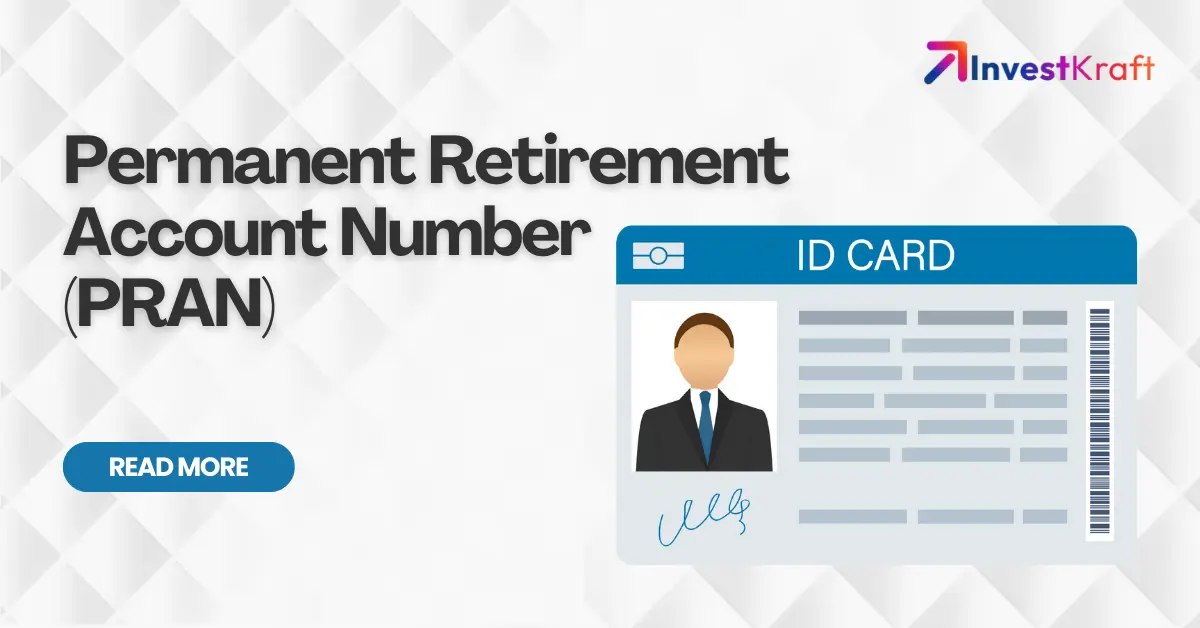What is PRAN in NPS?

The National Pension System (NPS) was established to give residents retirement income and to promote savings among the populace. It was exclusive to government recruits at the time of debut, but it is now accessible to all citizens. The central government introduced the co-contributory pension program, which allows eligible NPS subscribers to contribute a minimum of Rs. 1,000 and a maximum of Rs. 12,000 yearly, encouraging those working in the unorganized sector to save. This program was in effect from FY 2016–17. These savings must be deposited into a Permanent Retirement Account (PRA), which is required for NPS subscribers.
What is a PRAN Card?
Permanent Retirement Account Number (PRAN) is the full name of the Pran Card, which is a physical card. It is distributed by the Government of India's NSDL e-Governance Infrastructure Limited (NSDL e-Gov). The PRAN card essentially enables subscribers to safely access their pension account, providing them with convenient access to funds. This card is quite helpful for those who are National Pension System (NPS) subscribers.
All NPS subscribers must receive a PRAN card. It has a 12-digit unique identification number that serves as a distinguishing factor for both new and current subscribers.
In addition, the PRAN offers a way to view the subscriber's transactions, pension account information, and more. Ensuring that only authorized individuals can access their pension money is ensured with a physical card.
What is the PRAN number?
Each NPS member receives a lifelong, 12-digit Permanent Retirement Benefit Number that can be accessed anywhere in India. Below are the types of accounts that are eligible for PRAN. Every NPS subscriber is required to have a PRAN.
- The Tier I Account is designed for retirement savings and is not withdrawable.
- Tier II Account: This is essentially a tool for optional savings. Anytime he wants, the subscriber is allowed to take money out of this account. This account is not eligible for any tax benefits.
How to get a PAN Number online?
PRAN applications are accepted online and offline. To apply online for a PRAN, complete these steps:
- Use a legitimate login to access the eNPS portal at https://enps.nsdl.com. Then, choose 'New Registration.'
- Provide the necessary information, such as your name, phone number, email address, nomination details, and PRAN number based on your birthdate.
- Following registration, an OTP will be given to the registered email address or mobile number for authentication.
- KYC verification comes next when authentication is finished. This calls for uploading and submitting legitimate identity and address verification documents, such as a passport, voter ID, PAN card, etc.
- NSDL will provide the PRAN and an email including the PRAN number and other details as soon as the payment is successful.
- After a successful registration, the physical card will be mailed to the registered address in three weeks.
Documents Required To Get PRAN Number
One needs to furnish the following documents to get a PRAN no.
- Proof of identity (PAN card, driving license, passport, etc.)
- Proof of address (Voter ID card, electricity bill, ration card, etc.)
- Photographs of the applicant and nominee
- Passport-size photograph
- Cancelled cheque/bank passbook
- Annexure S1 or Annexure S2 forms
How to do a PRAN number status check?
Typically, the CRA - Facilitation Center receives the properly completed registration form, generates the Permanent Retirement Account Number, prints the card, and ships it out within 20 days. The POP-SP generates and provides a 17-digit receipt number as an acknowledgment to subscribers who apply for PRA. By providing the acknowledgment number, the subscriber can check the status of their application online or by contacting the Nodal Officer.
What is the process to get a PRAN number for a NRI?
Additionally, NRIs can apply offline or online for a PRAN. NRIs must visit the eNPS portal and adhere to the instructions in 'How to Apply for PRAN Card Online?' above to submit an online application. NRIs must complete an Annexure S3 form and submit it to the closest NPS Point of Presence (PoP) to submit an offline application. The aforementioned documents continue to be necessary for NRI candidates.
After successful registration, people will receive their physical PRAN card three weeks after submitting the required paperwork and the completed form.
How can you activate your PRAN card?
- Go to https://enps.nsdl.com to access the eNPS portal.
- Type in your PRAN and any additional information you feel necessary.
- To activate your account and obtain your login information, including user ID, password, and other details, generate a Time Password (OTP) on your registered email address or mobile number.
- After logging in, you may check all the information required for NPS programs and transactions made with this PRAN card status, as well as update or change bank details.
- To finish the activation procedure, select 'Activation' from the home page and input the OTP you generated previously along with the other information you supplied when applying for the PRAN card.
- Select 'Activate' to start your e-PRAN after all the information has been entered.
FAQs
Q. Is it possible for a subscriber to possess multiple PRANs simultaneously?
- No, a subscriber is limited to a single account.
Q. Can two accounts be opened simultaneously, one for Tier I and one for Tier II?
- Yes, by submitting a composite form, you can apply for both accounts simultaneously.
Q. Can an individual invest in NPS while also investing in another Provident Fund?
- Indeed. Your contribution to any Provident Fund is unaffected by your investment in NPS.
Q. Are all Permanent Retirement Account Number forms available at one location?
- Indeed, the NSDL portal has all the forms related to the Permanent Retirement Account Number.
In conclusion, the PAN (Permanent Account Number) card is crucial for several financial activities, including applying for loans, creating a bank account, and other bank-related activities. PRAN number is also important when arranging for retirement through NPS. You can make donations, keep track of and manage your NPS account, and carry out other NPS-related tasks with PRAN.
Related Posts;
- ELSS Calculator and How Does it Work?
- GST Calculator and How Does It Work?
- PPF Calculator and How to Use it?
- Benefits of using the Sukanya Samriddhi Yojana Calculator
- SIP Calculator and Its Benefits
Verify Phone Number
Related Post

10 Real Ways to Increase Your Income in 2026 (No Fake Apps, No Scams)
Are you cutting back on your dreams because your income isn’t enough? Or Are rising expenses f...
Read more...
Best Affiliate Marketing Websites in India 2026 – Earn Side Income Online
Some people are quietly earning ₹25,000… ₹50,000… even ₹1 lakh+ per month just by sharing link...
Read more...
How to Earn Money From Referral Marketing in India 2026
If you have been asking “Refer karke paise kaise milte hain?” or searched best refer and earn...
Read more...
Top 15 Work From Home Jobs in India 2026
If you are searching for work-from-home jobs in India, or ways to earn ₹1,000 per day working from h...
Read more...
Best Investment Options, Plans & Strategies in India 2026
Across India, beginners, salaried people, businessmen, students, and even retired individuals...
Read more...
Peer-to-Peer (P2P) Lending in India: Complete 2025 Guide to Risk, Returns, RBI Rules & Best Platforms
Peer-to-peer lending, also known as P2P lending, is when one individual lends money to another...
Read more...
Top 10 P2P Lending Companies in India 2026 (RBI Registered NBFC-P2P Platforms)
Peer-to-peer lending, commonly known as P2P lending, has become one of India’s fastest-growing...
Read more...
Top 10 Microfinance Companies in India – List, Benefits & RBI Updates
Microfinance institutions (MFIs) play a pivotal role in promoting financial inclusion in India...
Read more...
10 Best Foreign Banks in India 2025: Complete List with Features & Services
Foreign Banks in India play a very important role in offering world-class financial services,...
Read more...
Top Private Sector Banks in India 2026: List, Strengths, Services & Key Updates
Private sector banks in India have played a very important role in the country's financial sce...
Read more...Reach out to our Experts if you have any Doubts
Like the best things in life, Consultations @InvestKraft are free
Drop a Mail or give us a Missed Call & Begin your Investment Journey here







